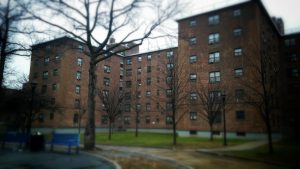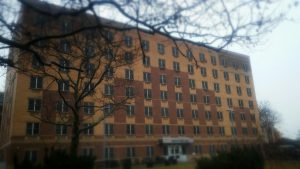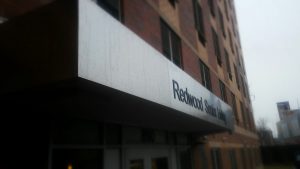NYCHA (New York City Housing Authority) started in the Modernist era of architecture. The concept was something new and unheard of, rent controlled housing for the city’s inhabitants. It started in the year 1934 marking the completion of New York City’s first urban complex. The very first complex was in the Lower East Village of Manhattan by architect Frederick L. Ackerman. The first in Brooklyn resides in Williamsburg called the Williamsburg Houses; it was built in 1938 consisting of 20 apartment buildings. The Red Hook East Houses complex remains the largest in Brooklyn with a whopping 27 buildings housing an estimate of over 2,500 inhabitants; the complex was established in 1939.
Since they all were supposed to be cost efficient, it resulted in them all looking the exact same way or something similar. The red, brown, and tan bricks would create an optical stereotype in the later years serving as a tell-tale sign of a proclaimed “project”. These buildings would be marked by a highly urbanized group of people; doused in, what I call, a true melting pot of cultures. Although these old buildings have a lot of history tied to them as various families once lived in them; serving as the only means of home for many childhoods, new government owned buildings are now hitting the public. Other than NYCHA the rent-controlled aesthetic in New York City is now considered outdated. So these new buildings are either called “senior living” or transitional housing for less fortunate families.
Since I lived in Brooklyn my entire life, I have been exposed to many iterations of these complexes. Seeing the new building in progress makes me see how the means of sustainability has severely changed over the years. It’s amazing to see what the new standard is for the current era of time. The older buildings’ were well equipped with updated programs like central heating and elevators for the elderly, disabled, and popular convenience. Now, the new technology being implemented is trendy alternatives of energy used from solar panels, and central air which eliminates the need for bulky air conditioners.
Looking at the new developments makes time seem very apparent as there is also a major change in overall look. The contemporary style has been carried out making the buildings not look like the same typical complex housing. I find it extremely fascinating how it’s so blatantly visible how time changes as the buildings stand adjacent to each other; an old veteran showing the rookie the new surroundings and what it has to offer. I guess sometimes you really can find the most intriguing subjects in your own backyard.












Love this article! You’re most certainly correct that NYCHA is now changing their over all appearance. I remember one day I was in a certain area in Brooklyn, can’t remember off the top of my head the name, however, the exterior of the the three-story complex looked like that of a less modern condominium. As someone who is accustomed to the reddish/burgundy brick building it was almost a culture shock seeing the “new” NYCHA “look”.